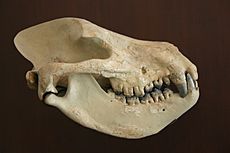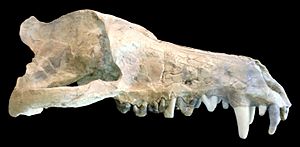Mesonychid facts for kids
Quick facts for kids MesonychiaTemporal range: Lower Palaeocene to Lower Oligocene
|
|
|---|---|
 |
|
| Harpagolestes immanis skull | |
| Scientific classification | |
| Kingdom: | |
| Phylum: | |
| Class: | |
| Infraclass: | |
| Superorder: | |
| Order: |
Mesonychia
|
| Families | |
|
Hapalodectidae |
|

Mesonychids were some of the very first meat-eating mammals. They appeared right after the dinosaurs died out. These amazing creatures are sometimes called "wolves on hooves" because they looked a bit like wolves but had hooves instead of paws.
They were closely related to animals like deer and pigs, which are called artiodactyls. Mesonychids first showed up in the early Paleocene epoch with a creature called Dissacus. They started to decline by the end of the Eocene and completely disappeared in the early Oligocene epoch.
What Were Mesonychids?
When the dinosaurs vanished, there were no big meat-eaters left on land. This was a huge opportunity for other animals. Mammals and birds started to change and grow into many different forms. They filled the empty niches (roles) that dinosaurs and pterosaurs used to have. This process is called adaptive radiation, which means many new species quickly evolve from one ancestor. Mesonychids were the first group of mammals to become large carnivores.
Ancient Competitors
Soon, mesonychids had competition. By the later Paleocene, other groups of land carnivores appeared. A giant flightless bird called Gastornis showed up. Also, another group of meat-eating mammals called Creodonts evolved. Creodonts became very important and were serious rivals to the mesonychids.
Even more important, the modern group of meat-eating mammals, the Carnivora, became significant in the Eocene. This group includes animals like lions, bears, and dogs. They started as small animals in the Paleocene. But as they grew bigger, they became direct competitors with the mesonychids for food and territory.
How Big Were They?
Many mesonychids grew to be very large. The most famous one, Andrewsarchus, had a skull that was about a meter (over three feet) long! This is much bigger than the skull of a modern Kodiak bear, which is one of the largest bears alive today.
Mesonychid teeth were special. Their molars (back teeth) were flat and often blunt. They probably used these teeth to slice meat or crush bones. Scientists think that many species might have eaten fish. The very largest mesonychids may have been scavengers, meaning they ate animals that were already dead.
Images for kids
-
Cladogram showing the position of the Mesonychia
See also
 In Spanish: Mesonychia para niños
In Spanish: Mesonychia para niños


